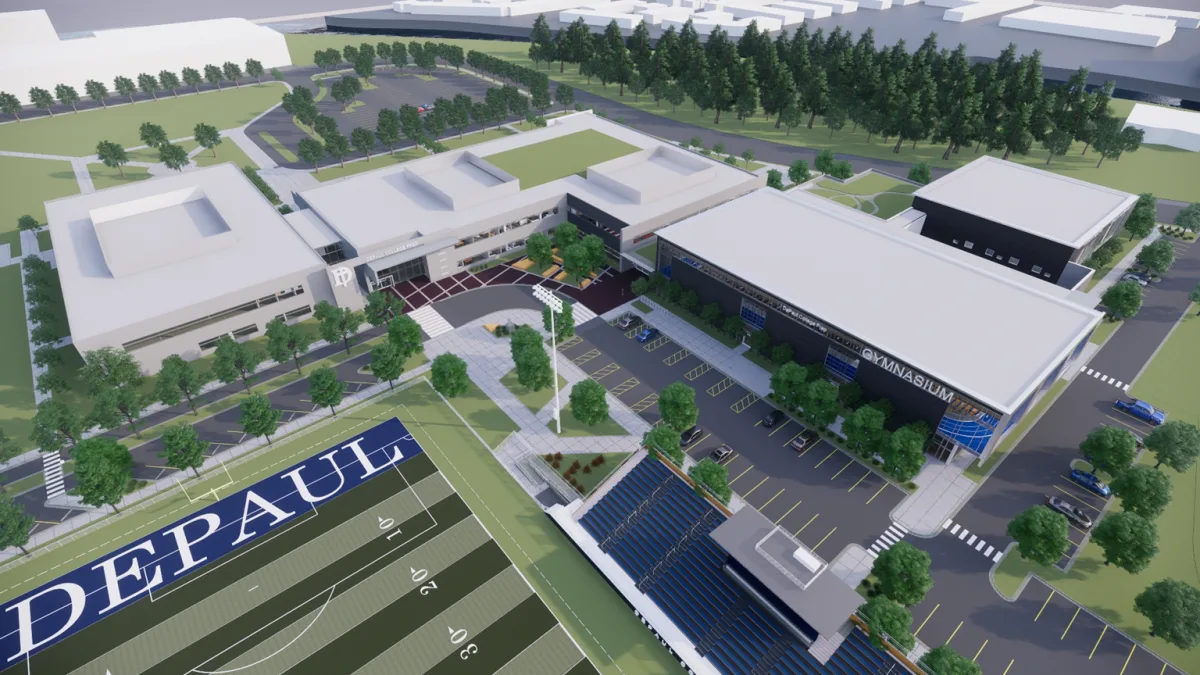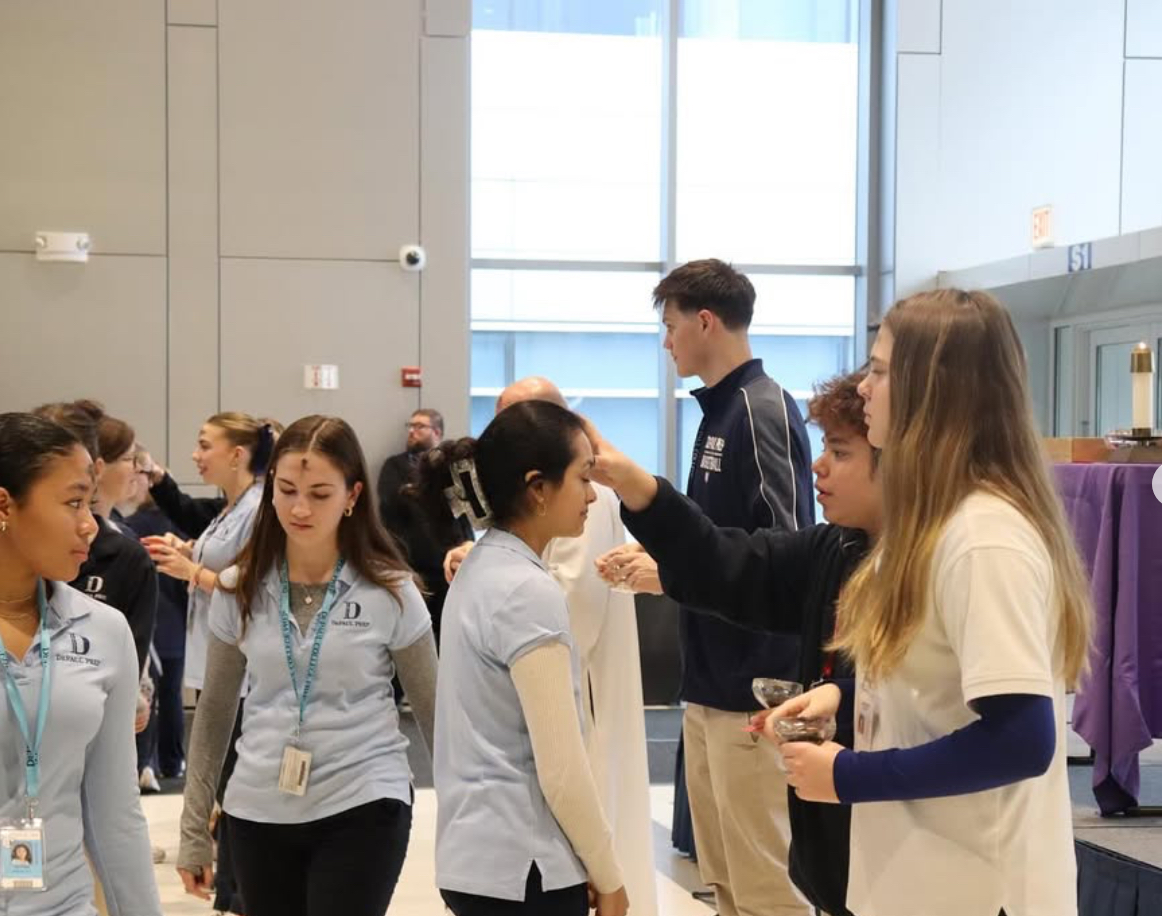In the ten years since DePaul College Prep’s official opening, many improvements have been made to the school. One of the most impactful changes has been the magnitude of the student body, with class sizes increasing from as few as 91 students in the class of 2020 to over 300 students. The current junior class is the biggest, with 352.
The school’s expansion came with benefits, including a wider variety of student opportunities, such as new sports teams like swimming and field hockey, and the ability to inhabit a larger, more updated campus.
At the outset in the 2020-20221 school year, the new campus consisted of only a single wing open for student use: the West Wing. That same year, a brand new stadium was built, which includes a football field, 110 meter track, and a concession stand. In addition to outdoor athletics, this space has been useful for holding assemblies, prayer services, and other all-school functions. The following year, in 2022, renovation of the East Wing was completed. Along with the additional classrooms came the Carlson Library, Corboy Hall, a new weight room, and a number of faculty offices and updated classrooms.
According to DePaul Prep’s President Mary Dempsey, $35 million raised in the capital campaign, which began in 2019, was invested into campus renovations and construction of the West Wing, East Wing, and the outdoor athletic stadium. New academic spaces for a growing student population were part of the campus planning process, along with plans for an indoor athletic complex. A new academic wing, the South Wing, was completed and open for use to begin this current school year. The South Wing includes several classrooms, laboratories, and a new dining hall. President Dempsey explained the need to prioritize new academic spaces in addition to new athletic facilities: “[DePaul Prep] is a school first.”
The school continues to focus on taking the necessary steps to make the indoor athletic complex a reality. Zoning for the complex has been completed. President Dempsey explained the importance of ensuring the necessary funds are secured before ground is broken; once construction is approved, the building will take approximately 14-16 months to be completed. According to President Dempsey, capital campaign funds designated by donors to support the athletic complex currently total over $8 million. No part of students’ tuition goes towards this project — all money comes from fundraising and grants.
Initial plans for the indoor athletic complex included up to three gym courts, a natatorium, a new-and-improved weight room, rooftop garden space, and many other sought-after amenities. Since then, some of the indoor athletic complex’s planned amenities have been adjusted. The plans for the complex now exclude a pool, because of the delay and additional insurance costs it would require; however, space has now been allotted for an additional track.
Athletics have adjusted
Many of the school’s athletic teams have still found success without having an indoor gym on campus. Most notable has been the boys varsity basketball team, who won their second consecutive IHSA State Championship this year.
Head Basketball Coach Tom Kleinschmidt said that adjustments have been minimal, since the team continues to utilize the gym at the former Father Gordon campus. Though DePaul Prep no longer uses the Gordon campus for its school buildings, for the time being they have still been able to utilize the gym. Many athletic teams have made use of the available resources.
When the new athletic complex is completed, Kleinschmidt expressed he looks forward to the accessibility and new practice space.
Head Girls Basketball Coach Sarah Zarymbski echoed this statement, saying that “the adjustments aren’t as different as you might think.” The varsity team practices at the Gordon gym, while JV and freshman teams utilize facilities at Northeastern Illinois University. This gives the team, “a consistent time slot to practice throughout the season.”
Zarymbski believes that the team has still been successful without the new athletic complex, and believes that, “moving to our new campus has allowed us to grow as a school. […] We’ve been able to bring in more athletes to really build a program. […] There is no point focusing on what you don’t have.”
The Kinetic Wellness Department also has adjusted to not having a gym on campus yet. Coach Michael Passarella, former Chair of the Kinetic Wellness Department, oversaw the department’s courses when the school initially moved to its current campus. He believes that the school has adjusted well, explaining how, “we’ve been able to kind of do everything. […] We utilize Gordon, or we try to stay outdoors.” Classes have also made use of the row house across the street when extra space is needed for yoga or other workouts.
The challenges of major construction projects
President Dempsey wishes to remind students, especially those eagerly awaiting the construction of the athletic complex, that DePaul Prep has only been around for a decade: “I don’t think there’s another Catholic school that in 10 years has done what we have done.” Each improvement that has been made to the school has been one with great thoughtfulness and planning behind it.
Adding brand new facilities to a school campus is a long process, not just at DePaul Prep. Saint Ignatius College Prep, a Catholic high school located on the South Side on Roosevelt Road, recently underwent several athletic facility improvements that included a new weight room; repainting, sanding, and sealing the gym floors; a new baseball field; and a new wrestling room. This project was smaller than DePaul Prep’s planned indoor athletic complex, but it illuminates the multi-step process required for these endeavors. St. Ignatius Athletic Director Mike Hurley emphasized how the planning process for even a simple improvement or project can take months to plan. Then it takes more time to fundraise the money.
Oftentimes, Hurley said, it can be hard for people to “see what it is that you are presenting. […] It’s an investment in a dream – a vision.” After that, projects can get delayed especially when they are done outside. Though the St. Ignatius baseball field was completed in time for the baseball season, it was delayed by a few weeks.
Hurley also reiterated Dempsey’s assertion that all these improvements are done “to benefit the student athletes, and to benefit our athletic teams and our programming needs.”
Though they take time, when new projects are complete, “it’s a really great experience to be able to see that” for their teams. The experiences at St. Ignatius help to reiterate just how much planning and work goes into athletic improvements no matter the size.
Looking ahead to possibilities
DePaul Prep’s athletic complex will certainly take time, but there is evidence it will be well worth the wait. It is currently projected for the building to include three multi-sport courts, a field house, batting cages, an elevated indoor track, a wrestling room, several multi-purpose rooms, conference rooms, a film room, and an elevated garden. Not only will this create a space for sporting events, but it will also be home to Masses, pep rallies, school dances, and many other all-school gatherings.
As Flo Merkl-Deutsch, DePaul Prep’s Director of Mission and Ministry, shared, “How we gather matters! The competition gym will provide us with the opportunity to gather as one community in a single space to engage in a shared experience of prayer, gratitude, and expression of our Vincentian Catholic identity. This is critical to deepening our culture and bonding as one Ram Family!”
DePaul Prep Athletic Director Patrick Mahoney agreed: “[The complex] will give us a solidified space where we don’t have to rely on outside sources.”
When the indoor athletic complex is completed, it will impact the school in many beneficial ways. For now, students have many existing resources they are able to use, and DePaul Prep looks forward to many more successes in the expanding sports program in the years to come.







